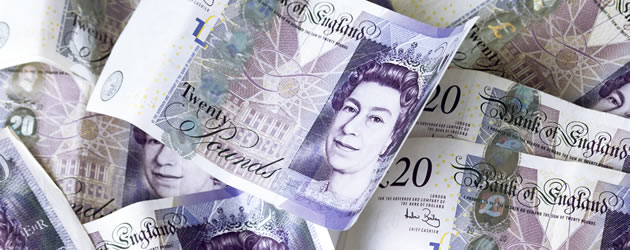- GBP Softens – EU referendum uncertainty weighs
- EUR Gains – ECB rate decision in focus
- USD Ticks Higher – ISM Manufacturing betters expectations
- Pound Edges Higher – Recovers some of this week’s losses
Pound Higher Vs. US Dollar, Euro Today
Before the weekend the Pound Sterling to Euro (GBP/EUR) and Pound Sterling to US Dollar (GBP/USD) exchange rates recovered some of their previous losses.
The Pound climbed back to 1.29 against the Euro ahead of the release of the UK’s services PMI and was trading in the region of 1.4430 against the US Dollar.
(Previously updated 08:30 03/06/2016)
GBP/EUR Holds 1.28 Before ECB Decision
A slightly softer-than-expected UK construction PMI had little impact on the Pound Sterling to Euro (GBP/EUR) exchange rate on Thursday.
The measure had been forecast to hold at 52.0 but actually declined to 51.2 in May.
However, as the construction sector only accounts for around 7% of total GDP, investor response to the release was muted.
The European Central Bank’s (ECB) interest rate decision is expected to trigger EUR movement as the European session progresses.
If the central bank refrains from mentioning any future adjustments to fiscal policy, the common currency is likely to rally against its most traded rivals.
As it stands, the GBP/EUR exchange rate is trending in the region of 1.2880.
(Previously updated 17:10 01/06/2016)
Pound Sterling (GBP) Exchange Rates Cool despite Unexpected Manufacturing Growth
In contrast to last week, in which the Pound advanced considerably versus its 16 most actively traded peers in response to favourable EU referendum opinion polls, renewed concerns that the UK will vote to leave the European Union have dampened Sterling demand.
Recent polls have suggested that the vote will be much closer than previous surveys indicated, with many showing ‘Leave’ taking the lead. William Hill betting company stated that bets over the bank holiday weekend were 85% in favour of a ‘Brexit’.
The British Pound has become increasingly sensitive to any developments regarding the referendum, with domestic data having a comparatively muted impact.
Today’s domestic ecostats showed the UK’s Manufacturing PMI came in at 50.1, bettering expectations of a rise from 49.4 to 49.6. The 50 mark separates growth from contraction.
In response to the British manufacturing data Rob Dobson, Senior Economist at Markit, stated;
‘The manufacturing sector continued its lacklustre start to 2016. Although key indicators for output, new orders and the headline PMI all ticked higher in May, the latest survey is still consistent with around a 0.8% quarterly decline in the official ONS Manufacturing Production Index. The sector will therefore remain a drag on broader economic growth, adding pressure on the service sector to sustain the upturn in GDP.’
Also weighing on demand for the UK unit today was a report from OECD that cut growth forecasts and warned of the potential negative impact of a ‘Brexit’.
‘The outcome of the referendum is a major risk for the economy,’ the OECD said in its Economic Outlook. ‘A vote for Brexit would heighten uncertainty, raise the cost of finance and hamper investment.’
Euro (EUR) Exchange Rates Gain ahead of ECB Rate Decision
Despite concerns that European Central Bank (ECB) President Mario Draghi will deliver a generally dovish speech following the central bank’s interest rate decision tomorrow, the Euro strengthened versus many of its peers today.
The appreciation is likely to be in response to hopes that Draghi will avoid expanding stimulus measures at this time with uncertainty regarding Federal Reserve rate hikes and the EU referendum outcome.
Domestic data did little to support demand for the single currency, with better-than-expected French manufacturing output the only positive result. Eurozone manufacturing output at near stagnation is signalling a slowdown ahead.
‘The disappointing performance of manufacturing adds to suspicions that the pace of Eurozone economic growth in the second quarter has cooled after a surprisingly brisk start to the year,’ said Chris Williamson, chief economist at Markit.
US Dollar (USD) Exchange Rates Edge Higher on Positive ISM Manufacturing Data
Thanks to heightened safe-haven demand, as commodities and global stocks prices fall, the US Dollar strengthened versus a number of its major peers. The Euro uptrend has somewhat slowed the US Dollar’s advance, however.
Now that Federal Reserve Chairwoman Janet Yellen recently stated it was now ‘appropriate’ to hike the officials cash rate, policy outlook has become far more data dependent. This means that data is likely to be far more impactful on US Dollar exchange rates.
The ISM Manufacturing PMI bettered expectations in May, although the data isn’t likely to add more pressure onto the Fed to hike rates as traders look ahead to key labour market data due for publication later during the week.
Somewhat limiting the appeal of the US asset, however, is ongoing political uncertainty as controversial Presidential candidate Donald Trump continues to garner support from potential voters.
In addition, the initial reaction from improved prospects of an imminent Federal Reserve rate hike has now faded. What’s more, traders have become less optimistic given the unlikelihood of a massive policy change ahead of the Presidential election.
There will be a number of significant domestic data publications this week, with traders’ primary focus being Friday’s jobs report. However, several analysts are not expecting positive labour market figures.
‘While opening the door wider for the next step of an orderly Fed policy normalisation, Friday’s jobs report is unlikely to advance more than marginally the bigger quest for high and sustainable inclusive growth,’ stated Financial Times.
The Pound Sterling to Euro (GBP/EUR) exchange rate was trending within the range of 1.2898 to 1.3038 during Wednesday’s European session.
The Pound Sterling to US Dollar (GBP/USD) exchange rate was trending within the range of 1.4422 to 1.4508.



